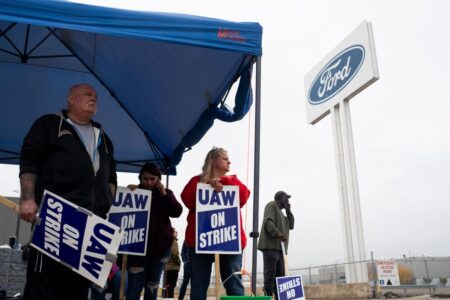(Bloomberg) — United Auto Workers President Shawn Fain indicated Friday that he is close to a deal with all three unionized automakers, but also warned that getting to the finish line could require striking more plants to pressure the companies into some final concessions.
Most Read from Bloomberg
Fain did not call for any more walkouts at US plants, saying he had received improved offers from General Motors Co. and Stellantis NV. Still, he told his members in a Facebook Live address that there is “more to be won.”
That sets up the union and the three automakers for a possible showdown in the week ahead. The union has 23% raises on the table from all three automakers but wants more. People familiar with the negotiations say that the union is now looking for a 25% wage increase.
It is also pressing the companies for better retirement benefits, job security measures and to add future battery plant workers to the contract.
Fain concluded his address telling all members to be ready to walk out to press management for some final gains.
“We’ve got cards left to play and they’ve got money left to spend,” Fain said. “That’s the hardest part of the strike. Right before a deal is when there is the most aggressive push for that last mile.”
GM and Stellantis may have headed off an expansion of the strike by matching Ford Motor Co.’s initial wage offer in the hours before his broadcast.
Talks have accelerated this week. GM said Friday it would offer most UAW workers $40.39 an hour, matching the 23% increase that Ford had already made. That raise, combined with cost-of-living increases, could get the total pay hike closer to 30%, which is the minimum the union hopes to achieve.
While all three companies have offered improvements for temp workers, including raises to $21 an hour at Ford and GM and $20 an hour at Stellantis, the union is still negotiating a pathway for future temporary workers to automatically be converted to full time, Fain said. So far, Ford has offered to convert existing temp workers to full time after 90 days, while GM and Stellantis have more temps and would take more time to convert them.
Fain said all three companies have reduced the time for new hires to get to top pay to within four years. Ford offered the best cost of living allowance to protect workers from inflation, and he wants GM and Stellantis to do more.
All three companies have agreed to boost pension benefits, Fain said, and to increase 401(k) contributions, but for current retirees Ford and GM are offering “deeply inadequate” lump sum payments and Stellantis has rejected increases, he said.
Ford talks picked up this week following a lull after the union struck the automaker’s largest factory, its Kentucky truck plant, on Oct. 11, according to people familiar with the negotiations who are not authorized to speak publicly about them. The two sides have resolved about 85% of the terms of the contract, one of the people said.
Though GM and Stellantis improved their offers to match what Ford proposed two weeks ago, Fain singled out Ford — and Executive Chair Bill Ford — for criticism, accusing the company of being unwilling to sweeten its offer since the union struck its Kentucky truck plant.
Fain rejected Bill Ford’s call for the union and the company to work together to compete against Tesla Inc. and foreign automakers operating in the US, such as Toyota Motor Corp.
“We won’t be used in this phony competition,” Fain said. “We’re not going to partner with Ford in a race to the bottom and we’re not going to partner with the Big Three to match the low standards of the non-union automakers. Instead, we’re going to organize non-union automakers everywhere.”
After Fain criticized Ford’s stock dividend payment, the company responded by noting that “tens of thousands of UAW members” have Ford stock in their retirement plans.
“Shareholders are owners of the company — and they deserve to be rewarded, too, when Ford does well,” the company said.
Read more: What’s at Stake as US Autoworkers’ Strike Drags On: QuickTake
Final sticking points in the Ford talks include how to cover future workers at battery plants under construction and at its Blue Oval City complex in Tennessee, which will include a new battery plant and an electric-truck plant when it opens in 2025, one person familiar with the talks said. The two sides also are still working out final economic terms, the person said.
GM did not immediately respond to a request for comment. In a statement, Stellantis said it had made progress on narrowing negotiation gaps: “Our focus remains on resolving those issues as soon as possible and finding solutions that protect the company and our employees.”
While picketing in Center Line, Michigan, on Wednesday, Gene Orr, a striking Stellantis worker said that the union has been “reaching for the stars” in contract talks. But ultimately he’d be satisfied as long as the contract has a sufficient pay increase and cost of living adjustments, protects health care and makes it possible for battery workers to unionize.
“Everything else is icing on the cake,” said Orr. “You can get the cake, but you don’t get the icing, so it might end up being a pound cake.”
John Jake Kincaid, a 27-year Stellantis employee, said “a lot of things that we gave up, we’re just trying to get them back.”
“They were doing bad, we sacrificed,” he said. Now that “they’re doing good, it’s time to reward us.”
(Updates throughout)
Most Read from Bloomberg Businessweek
©2023 Bloomberg L.P.
